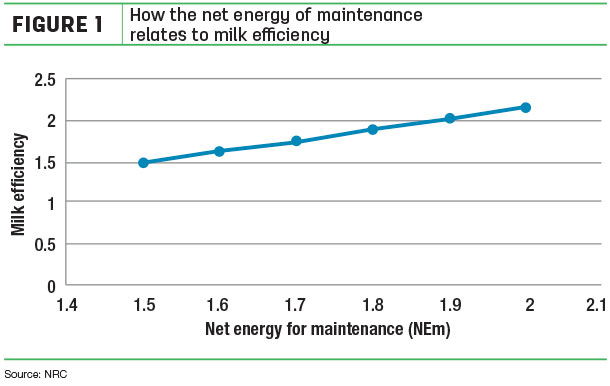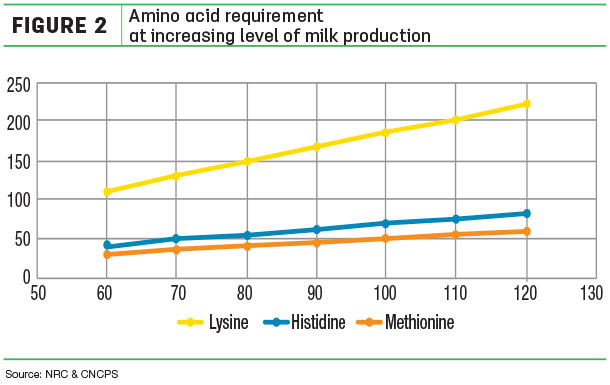Is your herd’s milk production being maximized? Is lactation performance being limited by a nutrient deficiency such as an amino acid deficiency? The potential for milk production is driven by energy. Yet the efficient use of energy is dependent upon adequate supply of amino acids.
Biologically, cows have the potential to produce more than 2 pounds of milk per pound of feed dry matter consumed – a 2-to-1 milk efficiency – from typical lactation diets (hay/silage/corn). Yet the production records of many commercial dairy farms are well below 2-to-1 milk efficiency.
Each 0.1 reduction in milk efficiency, from 2 to 1 (2.0), can be seen as a loss of 5 percent of the herd’s milk potential or as the consumption of 5 percent more feed than needed for milk production.
Maximizing energy use
Energy drives a herd’s milk production potential. The more energy-dense the diet, the greater the herd’s milk production. The relationship between milk efficiency potential and the energy density of the diet is shown in Figure 1 (100 pounds milk, 3.7 percent fat, 3.5 percent protein).

As the diet’s energy density increases, the efficiency of milk production can increase along with milk production itself.
For example, consider a group of cows producing 90 pounds of milk and consuming 56 pounds of dry matter with a 1.70 net energy for maintenance diet. The cows have a milk efficiency of 1.61 but a milk efficiency potential of 1.76. These cows are over-consuming energy for the level of milk produced.
Their efficiency potential of 1.76 means they could produce 99 pounds of milk on this diet without needing to increase feed intake, a difference of 10 percent in production. In this scenario, milk efficiency can be used as a diagnostic tool to determine whether milk production is near the expected biological potential of the cow.
How amino acid nutrition impacts milk efficiency
Milk production requires energy. Yet to efficiently maximize energy use, amino acid availability is required. Amino acids are used for maintenance functions – enzymes, hormones, tissue generation, etc. – and for milk protein synthesis. If amino acids are limited in supply, then milk production and milk protein will be reduced, which limits the efficiency of energy use for milk production.
The amino acids used in milk protein synthesis can come from either of two sources: the diet or body tissue. However, the breakdown of tissue is regulated and is limited as an amino acid supply for milk production. Using body tissue as an amino acid supply can be detrimental to reproductive success.
The diet, then, is the only means of providing amino acids at the level required to maximize the efficiency of energy use for milk synthesis.
The amino acid requirement of cows equals the amino acids required for maintenance plus the amino acids required for milk production. Amino acid requirements increase as milk production increases. Figure 2 estimates the requirements for the amino acids lysine, methionine and histidine as milk production increases.

If the efficiency of digestion and absorption is 80 percent, a cow producing 100 pounds of milk at 3.5 percent protein would need approximately 180 grams of absorbable lysine or post-ruminal delivery of 225 grams of lysine (225 grams x 80 percent = 180 grams).
If the diet provides sufficient energy for 100 pounds of milk but is deficient in absorbable lysine, the cow must meet its lysine needs by breaking down muscle. This is potentially detrimental to reproduction, increases diet consumption (which in turn decreases efficiency and increases feed cost) or decreases milk production (which decreases income).
To maximize milk efficiency, diets need to be formulated to provide amino acids based on the production potential as determined by the energy intake of the cow.
Potential of balancing amino acid to energy on milk profitability
While at the University of Missouri, I conducted an experiment at the university’s research farm to determine the effect of balancing lysine with the milk production of Holstein cows. Cows were fed a lactation diet (Table 1,) balanced using a commercial ration formulation program.

Amino acid requirements were then calculated based on the energy density of the diet being fed, and the estimated net energy for maintenance was at 1.55.
The diet formulated was assessed to be deficient in absorbable lysine and histidine. So the post-ruminal supply of lysine and histidine were increased using rumen-protected lysine sources, AjiPro-L and blood meal.
The cows’ lactation performance at approximately 150 days in milk was tracked for over 40 days. Cows fed the control diet consumed 64 pounds of dry matter and produced 92 pounds of milk, equating to a 1.44 milk efficiency. As estimated earlier, a 1.55 net energy for maintenance diet has the potential for a 1.56 milk efficiency.
Cows fed the diet with an increased post-ruminal supply of lysine and histidine consumed 1 pound less dry matter intake than cows fed the control diet, and they produced 5 pounds more milk. The milk efficiency of the cows fed the lysine-fortified diet was 1.54, close to the estimated maximum milk efficiency of 1.56.
Most importantly, milk production increased 5 percent with no increase in feed intake. The diet adjustments increased the diet’s cost by $0.24 per cow and increased milk income $1.67 per cow during the experiment. When the diet was adjusted to better meet the cows’ lysine requirement, $1.43 per cow per day was netted.
In research literature, lysine and methionine consistently are identified as the two amino acids most likely to be the first limiting in a wide range of lactation diets. With most lactation diets, lysine is first limiting.
Therefore, to maximize the production efficiency of dairy cattle typically requires the amino acids supplied in the diet be fortified. Milk efficiency then can be used as a diagnostic tool to determine if milk production is maximized in a herd or if a nutrient deficiency – most likely an amino acid – is limiting cow performance. ![]()
Monty Kerley is also a consultant for Gladwin A. Read Co.

-
Monty Kerley
- Retired Professor
- University of Missouri
- Email Monty Kerley






